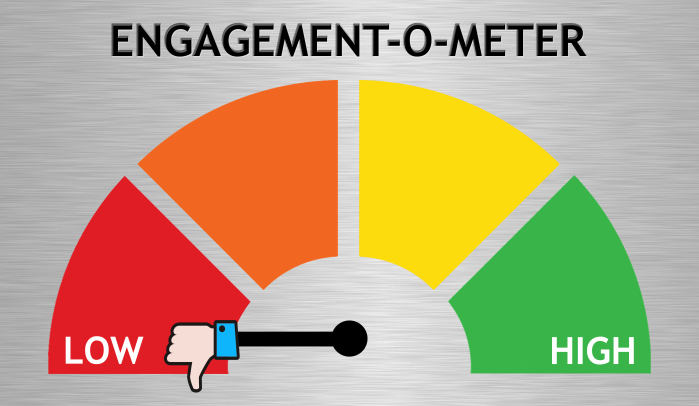UPDATED NOVEMBER 12, 2023
Why should I be concerned about a low engagement rate?
A low engagement rate is the Google Analytics 4 (GA4) version of a high bounce rate.
Remember your bounce rate?
Your bounce rate was one of the website performance indicators in the old Universal Analytics (UA).
It was the percentage of visitors who left your website from the same page they landed on. In other words, the visitors who landed on a page, then left without following any links or looking at any other pages.
If a high percentage of visitors were ‘bouncing’ off your website like that, it suggested there were issues with the site that were causing them to leave.


Why bounce rate has been replaced
Bounce rate was a limited statistic that didn’t always give an accurate picture of how your website was being used. Because there are all kinds of legitimate reasons why visitors might leave your website after only viewing one page.
For example, if your website only has one page or if your landing page:
- Fully answered their query
- Is a blog article they came to read
- Has a contact form on it and they filled it in.
This is why GA4, the new version of Google Analytics, doesn’t calculate your bounce rate and measures your engagement rate instead.
What is engagement rate?
Your engagement rate is the percentage of engaged sessions your website is getting.
What is an engaged session?
An engaged session is a website visit that:
- Lasts 10 seconds or longer;
- Has two more page views; OR
- Has one or more conversion events.
What is a conversion event?
An event is any interaction a visitor has with your website. That might be clicking a link, watching a video or downloading a file.
A conversion event is an event that results in a conversion. You can specify which events you want to count as conversions. For example, that might be if a visitor:
- Downloads your lead magnet
- Subscribes to your mailing list
- Successfully places an order
- Sends you an email
- Submits a contact form.
How is the engagement rate calculated?
Your engagement rate is shown as a percentage. It’s calculated by dividing your Number of Engaged Sessions by your Total Number of Sessions and multiplying that by 100.
Number of Engaged Sessions
________________________ x 100
Total Number of Sessions
What is the average engagement rate?
According to Orbit Media, the average GA4 engagement rate is 55%.
So you want to be aiming for upwards of that.
What if you still want to know your bounce rate?
If you still want to track your bounce rate, you can. It’s now inverse of your engagement rate.
For example, an engagement rate of 30% would mean your bounce rate is 70%. Or an engagement rate of 55% would mean your bounce rate is 45%.
10 Causes of a low engagement rate
If you’re getting a below average engagement rate, you might want to find ways to improve it.
In this section, we’ll look at some common reasons why your website visitors might not be sticking around or converting into customers.
1. Slow loading
Ideally, your website should load within 2-3 seconds. Any longer and your would-be visitors will start to drop off as they get impatient and go back to the previous page they were looking at.
A slow load time can affect your engagement rate, your page ranking, and your conversions, so it’s important to get it right.


What causes slow loading?
Here are a few possible causes:
- Large images or media files that haven’t been optimised properly
- Cheap, low-performance web hosting
- Too many fancy features and/or effects
- Custom fonts
- Messy coding.
How to speed up your load time
The action you need to take will depend on your site and where there’s room for improvement.
This GTmetrix tool will check your website’s load time and give you an actionable list of things you need to address.
2. Not meeting visitors’ expectations
If the page your visitor lands on doesn’t contain the content they’re expecting to see, chances are, it’s not going to engage them for very long.
This might happen if your page titles, descriptions or text links are misleading. Or if your advert takes them to a product page rather than a dedicated landing page.
Make sure you’re delivering what you promise
Go to your GA4 report and look at the pages with below average engagement rates. Then look at the titles, descriptions and links leading visitors to those pages and make sure they’re giving potential visitors a good indication of what the page is about.
3. Low-quality traffic
You should be aiming to attract high-quality traffic to your website. This means visitors who are the right match for what you’re offering.
If the visitors your website is attracting aren’t a good match, those visitors won’t be sticking around.
This can happen when keyword traffic is prioritised over keyword relevance and search intent.
- Keyword traffic
The number of times the keyword is searched for per month - Keyword relevance
The extent to which your chosen keywords are relevant to your content - Search intent
What users are intending to find when typing in a keyword.
For example, if you were to choose a keyword because it gets 10,000 searches a month rather than choosing one that’s relevant to the content on your page or that matches what your prospects are looking up.
How to attract high-quality traffic
When choosing keywords for your website, you need to check what web pages are already ranking for those keywords. The easiest way to do this is to go to Google, type in your keywords, then look at the results you get.
If the web pages listed are a good match for the content you’re trying to rank yourself, this shows the keyword is relevant and matches search intent. And that means it’s likely to attract the high-quality traffic you’re looking for.
4. Interstitials
Inter—what now?
An interstitial is an interactive page or pop-up that loads before the content your visitor has come to see or appears over the top of your content as the user scrolls down.
Interstitials might be lowering your engagement rate if:
- Visitors see the interstitial page instead of the content they’re expecting
- There’s a succession of pop-ups interrupting the user experience
- The pop-ups are difficult or impossible to close down
- Visitors find the interstitials irrelevant, unnecessary and/or annoying.
In any of these case, a visitor might decide to leave the site prematurely and without fully engaging.
How to make your interstitials less intrusive
Avoid using interstitial pages that appear before your main content. This will either confuse or annoy your visitors and it’s not worth the risk they might leave.
If you must use pop-ups for your offers or email sign-ups, it’s best to display them when your visitor is about to leave your site, rather than when they arrive.
You can also read my article: How to improve the pop-ups on your website >>
5. Non-responsive design
Your website should be optimised to display on a range of different devices, including smartphones and tablets. If this hasn’t been done properly, it can give some users a terrible experience, which might be causing them to leave your site before engaging.
How to check if your website is displaying properly
To see how your website is displaying on different devices, go to BrowserStack and type in your URL.
The content should automatically adjust for each device, as shown in the image below.


6. Poorly presented content
Poorly presented content is more difficult for your visitors to read and can be incredibly off-putting.
Examples of poorly presented content include:
- Huge walls of text with no paragraph breaks
- Columns of text placed too close together
- Long lines of text that span the whole screen
- Complicated and confusing layouts
- Centre-aligned text
How to present your content for easy reading
The content on your web page should be formatted for the web. This will make it easier for visitors to read on a screen, which means they’ll stay longer and read more of it.
To format your copy more effectively, use:
- A simple, single-column format
- Relevant headings to introduce each section
- Short paragraphs with a line space between them
- Short line lengths (7-12 words)
- Left-aligned text.
You can also read my article: Writing for the web? Here’s how to format your copy and content so it gets read >>
7. Badly written content
Badly written content can make your visitors want to leave for several reasons.
If it’s littered with typos, spelling mistakes and grammatical errors, it will make you look careless and unprofessional.
If it’s unclear, reads awkwardly or doesn’t make sense it will confuse your visitors.
And if it’s not written for your target market, it won’t ‘speak’ to your visitors as effectively as it needs to — so they won’t be engaged or compelled to read on.
How to write better content for your website
Hire a copywriter. Better still, hire me.
A professional copywriter will work with you to create effective web content that attracts your ideal customers, speaks their language and converts them into paying customers.
And rather than being an expense, the copy will be an investment, so it should more than pay for itself.
8. An unclear value proposition
When visitors arrive on your website, one of the first things they should understand is your value proposition.
But this might not be the case if your value proposition is vague or lacks clarity.
How to make your value proposition clear
Your website should open with a short explanation of:
- What you do — in plain English, with no jargon or buzzwords
- Who you do it for — show your visitors it’s for them
- Why they should care about it — how it will benefit them
- Why they should choose you — what makes you different/special.
9. A website that doesn’t seem trustworthy
When visitors come to your website, they’ll look for signs that you’re a genuine and trustworthy company.
They include things like:
- The latest website security certificate
- A postal address and landline number
- Professional accreditations
- Testimonials and reviews
- Social media links.
Signs your website might not be trustworthy include:
- Suspect content with bad grammar and typos
- Poor design with sparse attention to detail
- Spammy third-party advertising
- Broken links and 404 pages
- Insufficient contact information
- A neglected blog and social media channels.
If your website feels dodgy or doesn’t have the signs of a trustworthy website, visitors will be quick to leave.
How to convince visitors your website is trustworthy
Make sure your website has all the hallmarks of a trustworthy website, as shown in the first list above, and none of the dodgy signals in the second list!
You can also read the Trustworthiness section of my article: Practical ways to demonstrate E-E-A-T >>
10. Ineffective calls to action
If your visitors aren’t converting, this could suggest a problem with your calls to action (CTAs).
Common issues with CTAs include:
- Leaving your CTA too late and missing your chance
- Asking your visitors for too much, too soon
- Using CTAs that are unclear or confusing
- Not making your CTA obvious enough
- Not explaining the benefits of taking action.
How to make your CTAs more effective
If you want your website visitors to take action, your CTAs need to be well-placed, clear and obvious.
Visitors should be in no doubt about the action you want them to take, why they should take it and what will happen when they do.
You can learn more about CTAs and how to improve them in my article: 10 Ways calls to action can kill your conversions >>
How’s that website working out for you?
Is your website working well for your business?
Is it attracting your ideal customers?
Is it paying for itself and making you money?
Because it should be.
If your website isn’t engaging your ideal customers or working hard to bring you new business, maybe there are reasons for that.
And maybe you’d like an objective outsider, like me, to take a look at it and tell you what’s wrong.
I’m Jenny Lucas, a freelance copywriter and website specialist based in Leicester, UK.
I’ve created a comprehensive website audit service. It’s designed for deserving businesses with websites that just aren’t working. My audit will look at all the elements of your site that could be contributing to a poor performance and limiting your results, then give you practical advice on how to fix them.
If you’d like to find out more, visit my website auditing page or get in touch for an informal chat.


You might also like…






